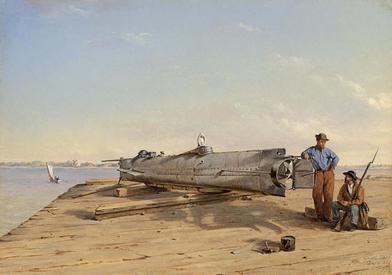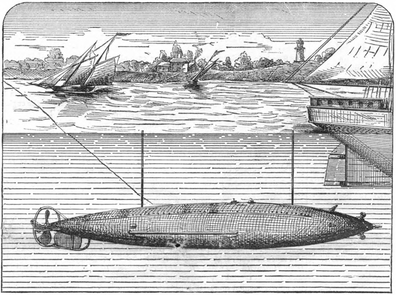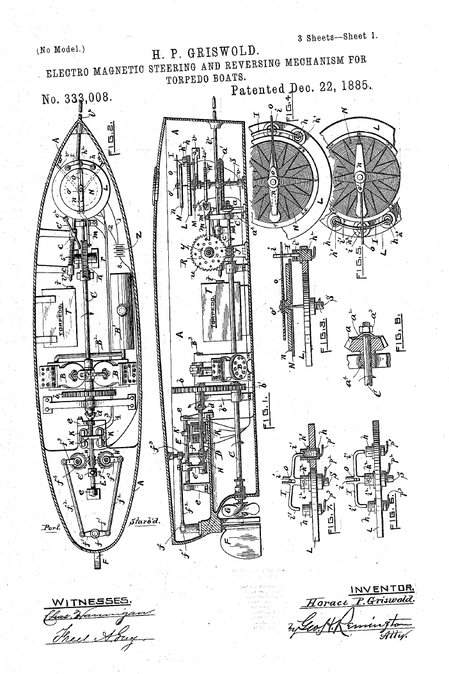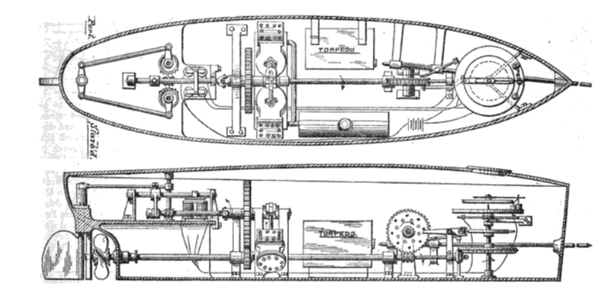 H.L. Hunley
H.L. Hunley
On December 22, 1885, U.S. Patent No.: 333,008 for an "Electro-Magnetic Steering and Reversing Mechanism for Torpedo Boats" issued to Horace Griswold of Providence Rhode Island. While it is now almost completely forgotten and had no real effect on the development of the modern torpedo, Griswold's invention did represent a technological milestone. It was the first internal guidance system for a munition.
The origin of the modern torpedo can be traced back to at least the early 1800s; however, it was the American Civil War that really gave the impetus to its development. During the Civil War, the term "torpedo" was used for what is now commonly referred to as a contact mine, which floated, partially submerged, and exploded upon contact with a ship. Another form of torpedo, the spar torpedo, was also used during the Civil War. The spar torpedo was an explosive device that was mounted at the end of a long spar that projected from the bow of an attacking vessel, which would ram a target vessel with the spar to detonate the explosive device. The most famous use of a spar torpedo in the Civil War was by the Confederate submarine H.L. Hunley to sink the USS Housatonic, which was the first time a submarine sank a ship during wartime.
Soon after the conclusion of the Civil War, the English engineer Robert Whitehead invented the first effective self-propelled torpedo, i.e., the modern torpedo. Commercially introduced in 1868 and originally called the Minenschiff (mine ship), Whitehead's torpedo was almost 12 feet long, carried an explosive warhead and was propelled by a three-cylinder compressed air engine. By 1870, the Whitehead torpedo (as it came to be known) had a speed of over 17 knots and a range of 800 yards. By any measure, it was an advanced weapon for its time. The only major feature the Whitehead torpedo was missing was a guidance system. This missing feature would not be provided by Whitehead until the late 1890s in the form of gyroscopic control.
The origin of the modern torpedo can be traced back to at least the early 1800s; however, it was the American Civil War that really gave the impetus to its development. During the Civil War, the term "torpedo" was used for what is now commonly referred to as a contact mine, which floated, partially submerged, and exploded upon contact with a ship. Another form of torpedo, the spar torpedo, was also used during the Civil War. The spar torpedo was an explosive device that was mounted at the end of a long spar that projected from the bow of an attacking vessel, which would ram a target vessel with the spar to detonate the explosive device. The most famous use of a spar torpedo in the Civil War was by the Confederate submarine H.L. Hunley to sink the USS Housatonic, which was the first time a submarine sank a ship during wartime.
Soon after the conclusion of the Civil War, the English engineer Robert Whitehead invented the first effective self-propelled torpedo, i.e., the modern torpedo. Commercially introduced in 1868 and originally called the Minenschiff (mine ship), Whitehead's torpedo was almost 12 feet long, carried an explosive warhead and was propelled by a three-cylinder compressed air engine. By 1870, the Whitehead torpedo (as it came to be known) had a speed of over 17 knots and a range of 800 yards. By any measure, it was an advanced weapon for its time. The only major feature the Whitehead torpedo was missing was a guidance system. This missing feature would not be provided by Whitehead until the late 1890s in the form of gyroscopic control.
 Lay Torpedo
Lay Torpedo
Between the introduction of Whitehead's torpedo and its later provision with a gyroscopic guidance system, other inventors attempted to solve the torpedo guidance problem. One of the most notable of these inventors was John Louis Lay, who relied on electric signals transmitted from a shore station or a mother ship to guide his torpedo. The drawback was that these electric signals were transmitted through a cable connecting the torpedo to the shore station or mother ship. Needless to say, this was an undesirable feature.
The desire to provide guidance to a torpedo independent of control from shore or another ship is what motivated Griswold to make his invention. Griswold's torpedo was capable of traveling a preprogrammed route through the operation of a complex steering system that included a slowly rotating worm wheel and a spindle connected to a holding disk and a compass needle.
The spindle was urged to rotate, but was prevented from doing so when the holding disk was engaged. The worm wheel was connected to the propeller shaft of the torpedo such that the angular movement of the worm wheel was proportional to the number of revolutions of the propeller and, thus, the distance traveled by the torpedo. Pins could be selectably inserted into different positions around the circumference of the worm wheel. When, through rotation of the worm wheel, a pin reached a certain, fixed position, the pin would move an escapement lever to disengage the holding disk, thereby allowing the spindle (with the compass needle) to rotate 180°. This rotation caused the compass needle to move 180° (to return to due North), which, in turn, energized one of two electromagnetic coils that moved a rudder of the torpedo to cause the torpedo to appropriately change direction.
As described above, the selective placement of the pins in the holes of the worm wheel was used to program the path of the torpedo, with the angular distances between pins determining the distances traveled by the torpedo between direction changes. In a working model of his torpedo, Griswold also used selectively placed pins in the holding disk to allow different direction changes (other than 180 °) to be implemented, with the angular distance between these pins determining the specific angular direction change.
When the torpedo was traveling in a straight path (with the rudder in a straight or steady position), any deviation from the path would cause the compass needle to move and thereby energize one of the electromagnetic coils to move the rudder and bring the torpedo back on course.
As mentioned above, Griswold built a working model of his torpedo, which was over six feet in length. He demonstrated this model to a group of interested engineers and munition manufacturers in Providence, Rhode Island, with great success. The model worked exactly as Griswold said it would. It traveled through a preprogrammed quadrangular path, totalling about 400 yards, and returned to within two feet of its starting point. While the demonstration was successful, Griswold was unable to subsequently convince the U.S. Navy or any munition manufacturer to purchase his torpedo. And with that, the Griswold torpedo disappeared into the forgotten pages of history.
The desire to provide guidance to a torpedo independent of control from shore or another ship is what motivated Griswold to make his invention. Griswold's torpedo was capable of traveling a preprogrammed route through the operation of a complex steering system that included a slowly rotating worm wheel and a spindle connected to a holding disk and a compass needle.
The spindle was urged to rotate, but was prevented from doing so when the holding disk was engaged. The worm wheel was connected to the propeller shaft of the torpedo such that the angular movement of the worm wheel was proportional to the number of revolutions of the propeller and, thus, the distance traveled by the torpedo. Pins could be selectably inserted into different positions around the circumference of the worm wheel. When, through rotation of the worm wheel, a pin reached a certain, fixed position, the pin would move an escapement lever to disengage the holding disk, thereby allowing the spindle (with the compass needle) to rotate 180°. This rotation caused the compass needle to move 180° (to return to due North), which, in turn, energized one of two electromagnetic coils that moved a rudder of the torpedo to cause the torpedo to appropriately change direction.
As described above, the selective placement of the pins in the holes of the worm wheel was used to program the path of the torpedo, with the angular distances between pins determining the distances traveled by the torpedo between direction changes. In a working model of his torpedo, Griswold also used selectively placed pins in the holding disk to allow different direction changes (other than 180 °) to be implemented, with the angular distance between these pins determining the specific angular direction change.
When the torpedo was traveling in a straight path (with the rudder in a straight or steady position), any deviation from the path would cause the compass needle to move and thereby energize one of the electromagnetic coils to move the rudder and bring the torpedo back on course.
As mentioned above, Griswold built a working model of his torpedo, which was over six feet in length. He demonstrated this model to a group of interested engineers and munition manufacturers in Providence, Rhode Island, with great success. The model worked exactly as Griswold said it would. It traveled through a preprogrammed quadrangular path, totalling about 400 yards, and returned to within two feet of its starting point. While the demonstration was successful, Griswold was unable to subsequently convince the U.S. Navy or any munition manufacturer to purchase his torpedo. And with that, the Griswold torpedo disappeared into the forgotten pages of history.



